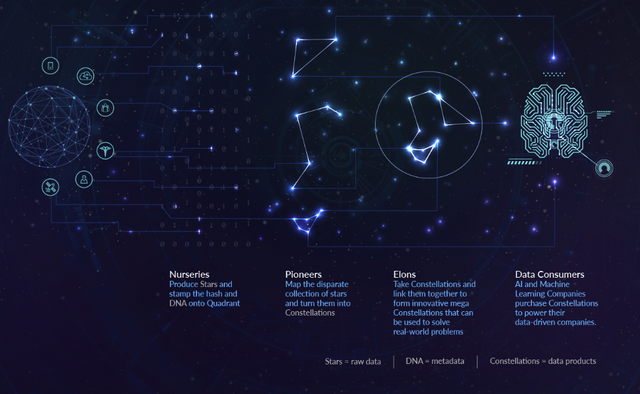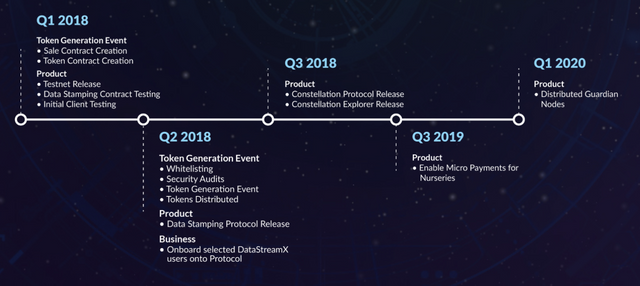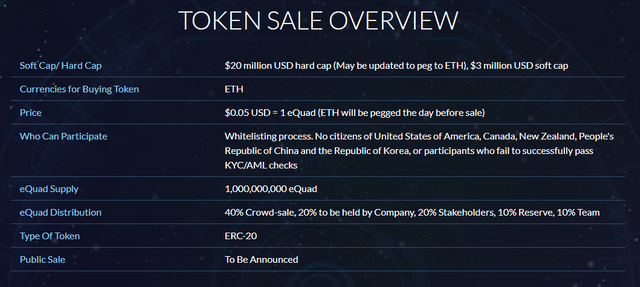Quadrant Protocol: A Visionary Blueprint for Organizing and Securing the Data Economy
Disclaimer
The following information is not financial investment advice. Please do your own research before making investment decisions.
Project Description: Quadrant Protocol is a data economy protocol on the blockchain, that will allow for a system of data products and services to built upon core tenants of authenticity and provenance (verifying the origin of the data). Quadrant is providing the blueprint for a decentralized data economy, which they will and are making partnerships for so that this blueprint can be realized.
What is the Problem?
There are at least 3 data economy problems that Quadrant wants to address with their protocol.
- The AI data gap is widening between the haves and have-nots; small companies can't properly use their algorithms or create AI innovations because they are lacking huge volumes of data
- A seemingly unending torrent of fake, inauthentic data which results in a bunch of algorithms being effectively meaningless since they were built to use real data. Otherwise, the information they produce is also false, and useless to the ones who paid to develop and run those algorithms.
- Original data producers not being adequately compensated for their contributions, resulting in lack of volume and lack of authenticity (motivation problem)
What is the Solution?
Quadrant Protocol's answer is to provide a blueprint for mapping and coordinating seemingly unconnected and dissimilar data sources in a way that is veritably authentic, efficient, and gives incentives to everyone involved. Their data stamping process will allow us to confirm data sources and thereby confirm authenticity; if you know the source of your data, you can confirm that the data has not been altered during its 'travels'
This blueprint is made up of the following components:
- Constellations - smart contracts for data
- Nurseries - the data producers; compensated fairly every time their data is used by constellations
- Pioneers - data vendors - Provided with incentives to create innovative, new constellations (expanding the Quadrant economy and relevance)
- Elons - Network actors focused on linking different constellations (the data smart contracts) to create larger constellations to be used by data consumers to solve real-world problems (this would be how actual organic growth will occur)
- Guardians - master nodes - Ensure that the constellations created by pioneers (those creating the constellations) are not compromised ; they will stamp, authenticate, and verify data and be compensated for securing the network in this fashion
- The only hiccup here is that guardian nodes are the last piece of their current roadmap, slated for Q1 2020, though their project will be up and running well before this; However, the project will have alternative solutions implemented for these jobs, at least until the guardian nodes are running.
What Sets Quadrant Protocol Apart
Proof of Authority - this consensus mechanism will allow for the network to prevent bad actor nodes from entering data, while also allowing for higher throughput (faster and more TPS), at a cheaper gas price. This proof of authority is how they will operate and secure their own blockchain. Yes, Quadrant is not just going to be a protocol built on top of another blockchain.
For further security, they will be anchoring their network by running it in parallel on a separate proof of work blockchain. Currently, that is set for Ethereum, but are willing to pivot to a different blockchain for this, if needed (e.g. scalability, etc). This anchoring will help deal with malicious/bad actor nodes that might try to put false data into the network.
They are not focused on TPS. See that they mention they will run on their own blockchain, especially for scalability reasons, but aren't hyping up a specific TPS goal? I predict the reason is at least two-fold:
- They don't need to enter the hyper-scalability blockchain race. Their blockchain will be focused on one thing and won't need to host multiple dapps doing different things. Instead they can develop their blockchain to efficiently support their specific goals, and can likely make use of some of the off-chain solutions being developed, if needed down the road. Their testnet results sound promising, as well, though the difference between mainnet and testnet results can be quite large.
- They are a serious project, not focused on trying to pump their project with outlandish TPS claims. Instead their nose is to the grindstone, which is demonstrated in part by sticking largely to their roadmap and developing useful partnerships and advisors.
One last thing that sets them apart is their relative lack of greed and fiscal responsibility. I will get into this later in the review.
TL;DR - POA, scalability; parallel security mechanism; serious project; fiscal responsibility
Competition or Collaboration?
If you have been interested in the ICO and crypto space for awhile, you might have noticed that one of the most common crypto projects seems to be data-focused projects. Those where the average consumer can monetize their data.
A fair question would be whether or not this sector is overly saturated with competition. Can Quadrant Protocol compete?
My response to you is that they likely don't have to. This is part of what is so brilliant about the Quadrant Protocol design. Other data economy crypto projects can actually become partners instead of competition. Any of these projects can become data producers (nurseries) to the Quadrant Protocol. Since nurseries are compensated fairly every time their data is used, this is a mutually beneficial relationship.
TL;DR - Collaboration
Roadmap and Progress to date
Tesnet - launched May 14th
- real client data is already being stamped (allows for confirming authenticity to know that the data has not been altered; if you know the source of your data, you can ensure it is not changed during its 'travels'
- results include ability to allow for tens of thousands of data feeds to stamp 1.92 TB per minute onto the chain. That is a TON of data, so this is great news to hear from the testnet results so far, as it speaks to scalability; notice how they didn't even talk about TPS here, but instead described what their testnet is allowing for in terms of real-world use? To me, this is one indicator you can look for to find serious projects
- testnet showing capability to allow clients to choose what size of data is being stamped per stamp, within a range of 50 to 400 MB, allowing for some flexibility depending on what clients need
Mainnet - this is the next goal on their roadmap that the team is currently working on. They are currently saying , please wait for an announcement. Till now, they have followed their roadmap quite well and followed through on what they've said, so I do hope that their mainnet will launch actually quite soon.
TL;DR - testnet good; mainnet any day?
Team
I think the team could be stronger, especially in blockchain experience. You could argue that they can outsource this experience, especially post-ICO once they have the extra funds for it. Serious projects often announce big additions to their team post-ICO.
The lack of blockchain experience also somewhat supplemented by their advisors, especially Benedict Chan from BitGo & Pavel Bains from Bluzelle. If they can use their partnerships and connections they are forming to grab some serious blockchain development experience, it will be great news for the project.
What I do like about the team is that many come from the same previous company, DataStreamX. Many people might not care about this, but it's honestly important. 7 out of 8 of the core team have been working at this company for at least a year and they all agreed to move to this project with the CEO. What's important here is the development of a team. They aren't random strangers all joining from different parts of the world and have never worked together before. They already know they can and already do work together as a team.
This could be a big positive for the project moving forward, missed by most traditional ICO metrics and reviewers.
Furthermore, all of the members coming from DataStreamX are coming from a company whose focus has been on building and running a global marketplace for commercial data. As far as relevant experience outside of blockchain goes, yes they have it. Their website states they allow for 18 billion records to be transacted per month and they have 230 data products currently available to be bought on their marketplace. From what I can tell, they plan to use the data here and their existing partnerships and userbase (a commercial userbase) to help drive real adoption and use of Quadrant Protocol.
If they can effectively incorporate their existing customers into the Quadrant Protocol, that will be fantastic for the project.
TL;DR - Very relevant real-world business experience; good teamwork potential; needs to supplement with blockchain experience (they seem aware of this)
Partnerships & Advisors
Bluzelle - If you don't know much about the data economy blockchain space, you might initially assume that Bluzelle would be a competitor to Quadrant Protocol. This could not be more inaccurate. They are more like two jigsaw puzzles that could end up fitting together perfectly.
Here is a quote from Quadrant's Medium describing the relationship:
"Quadrant Protocol allows its users to access, create, and distribute data products and services on their blockchain-enabled protocol. Bluzelle’s decentralized database solutions will give users of Quadrant a new and innovative storage opportunity with advanced data access security. For Bluzelle’s users, this translates to higher usage rates of their storage. Data transactions on Quadrant that have Bluzelle chosen as storage solution will allow data to flow into Bluzelle’s decentralized storage providers."
Put simply, this will improve outcomes for Bluzelle and Quadrant users. Furthermore, it incentivizes their new tech advisor, Pavel Bains, CEO of Bluzelle, to assist Quadrant Protocol team in succeeding in their project, in both vision and roadmap. That is to say, he won't be another one of those advisors you hear about that don't actually do anything, but provide credibility to a project.
I appreciate that Quadrant took the time and detail to expand upon the relationship of the partnership and why it was done. I have seen many other projects which will hype up partnerships and call them 'strategic partnerships', but fail (perhaps intentionally) to provide any sort of explanation as to the purpose of the partnership. If you are a long-term investor, you should be wary of any such project with practices like that.
Furthermore, they already have several data providers lined up to be part of their ecosystem, who you can see in the below graphic. I am hopeful we will see this list grow alot:
TL;DR - Useful, practical partnership with Bluzelle; well-explained; initial data providers lined up
Token Sale
The things that stand out to me in this token sale are two-fold:
ICO Funds locked-up: If the $20 million hardcap is reached, 60% ($12M) of the funds will be locked up, with 15% ($4M) of the total or 1/4 of the locked up funds distributed every year. Furthermore, they state they have a safeguard to ensure proper handling of funds, but refused to go into details for security purposes, which I could understand.
- To be clear, I have not seen another ICO essentially volunteer to lock up funds. To be sure, it is very rare. We hear about team token lock-ups all the time, but not the funds raised in the ICO. Very cool and shows intent and commitment, as well as fiscal responsibility.
Team tokens - Only 10% of total supply; unlocked over a period of FIVE years, at a monthly rate of about 1.66% of their total amount they are allocated. That's actually insane compared to other projects. Not only is the amount of tokens they are getting rather small, but the lockup length is super long and it's a very slow, steady distribution, meaning token price won't dump from it.
- Furthermore, think about the intent behind this. It is my opinion that this is an ongoing monthly incentive to the team members to stay with the project, and work hard to develop and implement the project and stick to the roadmap. If they were not committed, serious, and sincerely believed in their capability to pull off this project, there is no way they would structure their lock-up like this. They are not required to in the current ICO space where it's simply quite easy to reach hardcaps, seemingly regardless of metrics or lockups.
TL;DR - ICO funds AND team tokens (10% token supply) locked up & distributed over 5 years; shows serious commitment & intent
Conclusion: Long term Interest
I really like this project in the long term and I think they have a good shot if they can continue to make good, useful partnerships and supplement their team in the lacking areas. If they continue to show progress, this could be a solid long term play. Their token metrics and ICO fund management is unheard of in the past months and they are definitely playing the long game. I love their commitment, intention, and belief in their own ability to succeed.
It is also possible this could be a good short term play. The token metrics are pretty good and there is a large sector of crypto investors that are not allowed access to this crowdsale. USA, Canada, New Zealand, China, and Korea are all not allowed to participate in public and private sale.
Overall, I'm excited to see this project succeed over time. It is definitely a data economy project that could become a massive player in the crypto data space.
Quadrant Telegram: https://t.me/quadrantprotocol
Quadrant website: http://www.quadrantprotocol.com/
Quadrant Medium: https://medium.com/quadrantprotocol
If you enjoyed this review or other content I've created, I would strongly appreciate if you upvote or comment on those articles, follow me on twitter, and/or join my telegram below (if that interests you). Thank you so much!
Telegram group
Telegram Announcement channel
ICO spreadsheet
Twitter





Additional Quadrant Protocol Links:
Bitcointalk ANN Thread
Bitcointalk Bounty Thread